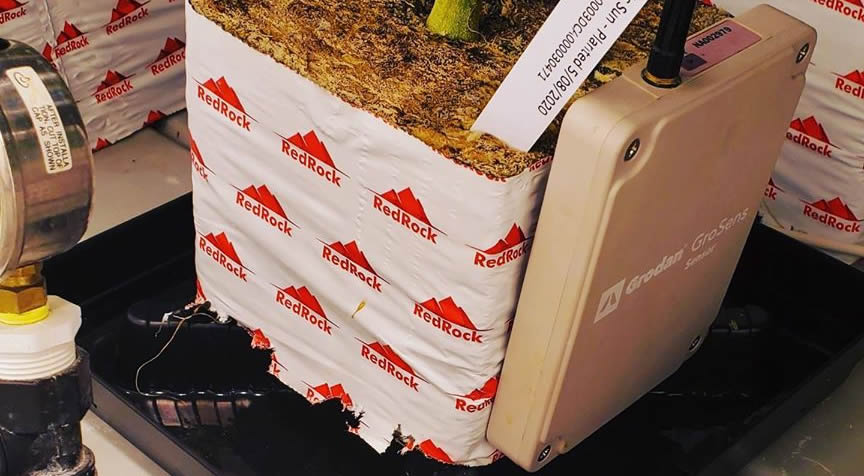Managing Electrical Conductivity with Stonewool Grow Media
Electrical Conductivity in Horticulture: An Overlooked Key to Unlocking Potential in Crops
In the commercial horticulture industry, there is an increasing push to produce more with less inputs. In order to do this, growers often think that this will sacrifice the quality in exchange for the quantity demanded. This is far from the truth as quality does not have to be sacrificed for the numbers. In order to keep up with demand and overall expectations of the operation and potential customers, an operation needs to focus on the main needs of a plant. These range from temperature, air flow, media, lighting, environmental factors, and plant nutrients. With these needs, a grower needs to ensure that all are met in correlation to the crop needs.
One of the most common frustrations of commercial growers are phrases along the lines of “chlororic” and “lack of feed”. As growers are focused on fixing a problem when it arises instead of preventing the issue, these problems arise quite frequently for crops. This is largely due to an error in crop management techniques. An often overlooked aspect of crop management is the electrical conductivity in the growing media. Electrical conductivity or EC is an important factor in the growth of crops in all stages of growth as it regulates and controls the nutrient uptake of plants. Electrical conductivity is the total measure of dissolved salts in a solution. This factor influences the ability of the plant to absorb water, and in hydroponic applications, this includes water based plant nutrient solutions. This factor is known as salinity. EC is an overall meaningful indicator of water quality and fertilizer concentration. By understanding EC levels, plant production can lead to a more cost effective use of inputs and less shrinkage of crops. This is due to the effects of high salt concentrations as a key indicator that adjustments need to be made before damage is dealt to the crop and shows up as a proverbial “plant health crisis”.
Electrical Conductivity Control in Stonewool
Stonewool is one of the most popular types of grow media for the commercial hydroponic industry. This material is a natural grow media developed through the melting and spinning of basaltic rock. Once spun, this material is shaped into stonewool cubes, stonewool blocks, stonewool slabs and more for the growing of crops. What was once only used in the construction industry was redesigned and engineered to be an excellent growing media. When dealing with stonewool applications, it is important to understand the properties of this material. This understanding will enable a grower to make choices that are ideal for the media and plant as the properties of stonewool are very different from the traditional approaches to growing crops in soil or soilless media.
Stonewool has many beneficial properties that make it the ideal media for commercial hydroponic operations. Stonewool is able to retain air and water at adequate levels, can be reused through several crop cycles(in some cases…), is naturally sterile, can be monitored and controlled easily, and is ideal for hydroponic growing systems. When handling stonewool, it is essential to wear proper PPE to reduce the risk of eye, lung, and skin irritation from dust and fibers during processing and prep. In addition to these benefits, the major benefit of stonewool over soil is that ability to grow in less space without compromising on water and plant nutrient availability for the crops.
As this material is inert and sterile, it is the perfect media to build and control EC to ensure proper nutrient and water uptake by the crop. In order to properly control EC in stonewool it is essential to monitor the solutions running through the system. After stonewool is rinsed and soaked before planting, the pH is generally neutral (depending on the water pH running through the system). The same can be said for the EC of the material. The monitoring of the water and nutrients running through the system is the key to monitoring the EC and pH levels. These solutions can be checked by using an EC meter. EC meters can be either manual or automatic with automated testing units. A grower should test the water and solution frequently to catch any sudden changes that can cause harm to plants. The secret to proper EC control is prevention not reaction. Once the EC is stabilized relative to the individual crop needs, pH should also be balanced. By monitoring both EC and pH on the daily, a grower is better able to produce the quantity needed without sacrificing the desired quality.
There are acceptable ranges of EC and pH in the water solution that comes into contact with the crops. By staying within these ranges, the crop is happier and healthier. However, a grower should not over-saturate or over-irrigate the growing area to try and balance the EC. Instead this needs to be a gradual control and should be driven based on the state of growth of the crop and the general needs of the crop. Some crops such as tomatoes compared to peppers prefer a higher EC.
For more information or help with deciding the best approach to controlling EC in the commercial greenhouse, RedRock Block staff and consultants are at the helm ready to provide combined decades of experience in the field. With services in installations, recommendations, planning, maintenance, and more the RedRock Block team is ready to help all types of commercial and industrial greenhouse, CEA, indoor farming, hydroponic, and in-field farming operations.
https://www.redrockblock.com/shop/



